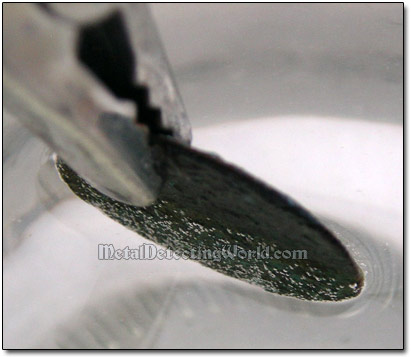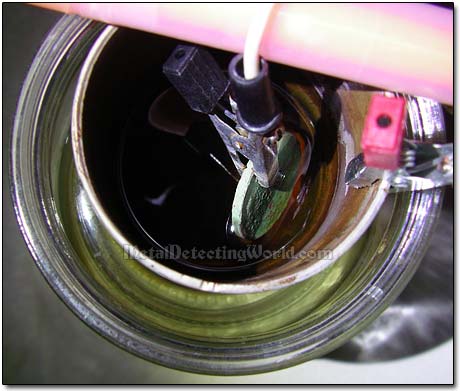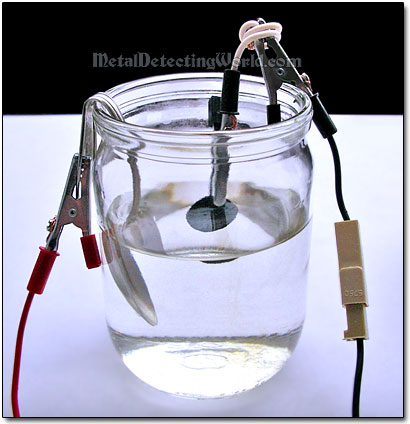How To Clean Coins and Jewelry with Electrolysis - A Detailed Tutorial, page 14
Preparing Electrolytic Cell for Electrolysis
(...CONTINUED from Previous Page)
3) How To Place Electrodes in Electrolyte Properly
Proper placement of electrodes into electrolyte is essential for the process. To make sure the electrodes are set up correctly, follow these instructions:
• ANODE (positive electrode, "waste" electrode) should protrude out of the electrolyte so that the power clip (clamp) could be attached to it.
• The positive power clip CANNOT be immersed into the electrolyte because it will quickly disintegrate!
• The anode MUST NOT touch the coin being cleaned, or short-circuiting will occur.
• The anode must be firmly set (maybe with use of a clamp or other means to hold the anode in place) inside the jar so that it cannot move freely and accidentally shift onto the coin.
Some sources state that the cathodic power clip can be submerged since the electrical supply is preventing it from rusting; however, I would recommend to keep the cathode out of the electrolytic solution when you clean a completely encrusted coin. If you immerse the cathode into the electrolyte along with the encrusted coin, the cathode will be a part of the electrolytic cell but the coin will not (no bubbling) due to the thick and insulating layer of crust, hence, lack of electrical contact with the electrolyte.
The current takes the least-resistant electrical path - through the immersed cathode, but not through the encrusted coin, or just partially, so the coin is receiving the least amount of current. Most energy can be wasted for splitting water at the cathode until the coin slowly gets cleaned enough to receive an adequate amount of current. So usually I keep the cathode out of the electrolyte unless I see a satisfactory reaction going on at the coin. Another reason I do not immerse the cathode in electrolyte is that I do not want the cathode to be contaminated with toxic hexavalent chromium that appears in the electrolyte when the stainless steel anode is used.
Because the cathodic power clip is not supposed to be immersed in solution, and, therefore, a small area of the coin, to which the clip is attached, is not being treated, the coin does not get fully cleaned at a time. The remaining untreated area should be cleaned in its turn, and if you process it a little longer than necessary, there will be no visible difference between the coin's two areas being treated individually. So there is nothing to worry about.
Only Two Thirds of Coin Are Immersed

4) "Line of Sight"
The efficiency of electrolysis is based on the principle of "line of sight" which means that the current in the electrolyte tends to travel between anodes and cathodes in direct lines rather than around objects that block the "view". For example, only the side of the coin that faces the anode, will be cleaned.
With the electrolysis machine of the "classic" type, sufficient current can be brought to both sides of the coin by turning the coin - you have to be patient to make sure each side is treated for an equal amount of time. This is indeed very time consuming.
As the "Pipe" electrolytic coin cleaner incorporates the pipe-anode that surrounds the coin, such setup ensures that both coin's sides are simultaneously treated and get an even distribution of the current. Since no "blocking effect" takes place, the coin cleaning will be completed in less time.
"360° Line of Sight" in "Pipe" Electrolysis Setup

5) Suspend Coin in Electrolyte Properly
Proper placement of coins and other objects into electrolyte is crucial for the process. To make sure that the coins are properly set up in a container, follow these simple rules:
1. A coin MUST NOT touch the anode, and should be positioned immovably inside the container so that it cannot accidentally bump into the anode. The coin's contact with the anode may cause shorting of the power supply.
2. The coin should be suspended more or less at the same level in the jar as the anode (a bowl of the spoon), and facing the anode. (this rule does not apply to the cleaner of the "pipe" type)
One-Side Coin Treatment in Classic Electrolysis Setup
